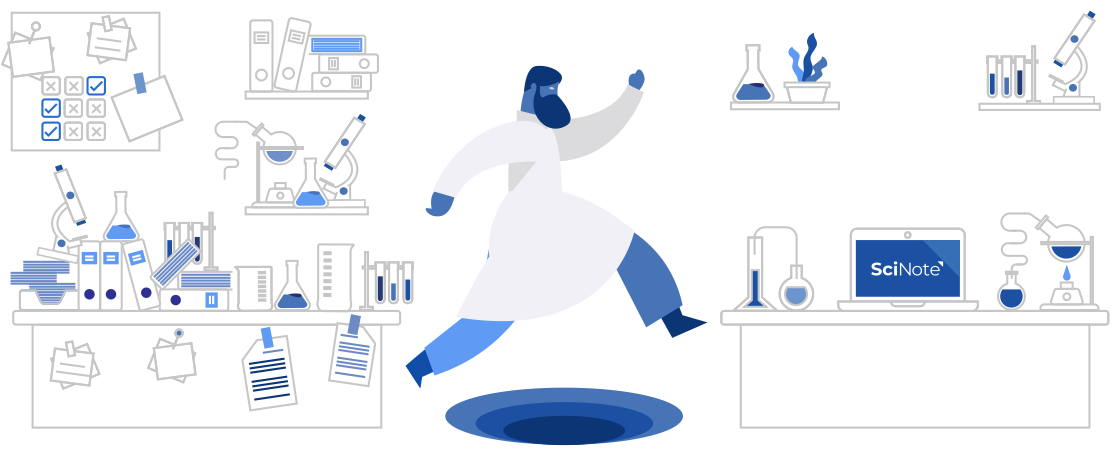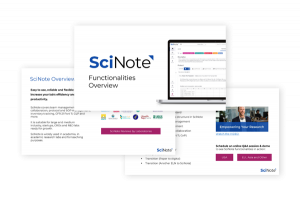Digitalizing your lab? 3 pitfalls to avoid in digital implementation [checklist]
Learn about the most common pitfalls we have seen organizations fall into when trying to implement digital systems for lab management, and what steps you can take to save yourself a lot of headaches (and money) down the road.
![]() 9 min read
9 min read
There are many advantages to transforming your lab digitally. And we are not talking about just scanning all your lab notebook pages into the cloud. We are talking about digitalization – connecting your lab processes through digital means, and taking advantage of the benefits lab management digital tools and platforms can offer. Instead of each process sitting in a silo, you can connect protocols, lab notes, research data, inventory management, and in some cases even equipment to work together, thereby creating opportunities to automate lab procedures or mine the data for new discoveries or costly errors. It can also help you adhere to regulatory requirements like FDA 21 CFR Part 11 and good manufacturing practice every step along the way.
According to a recent report by Accenture, 70% of the Life Sciences industry leaders who are scaling or have scaled their digital efforts in the labs see the expected or exceeding expected return on investment (ROI).
This all sounds great, but what about actually making it happen? Digital transformation doesn’t happen overnight, and implementation takes work. Labs large and small have faced this challenge – some are able to adopt to changes and move into the digital age, while others fail with money and time wasted. In this post, we will share the most common pitfalls we have seen when organizations try to implement digital systems in their labs, how you can avoid them, and why having a partner during the implementation can save you a lot of headaches (and money) down the road.
Content
Why is the implementation process critical?
When it comes to purchasing a digital solution that will fit your laboratory’s needs, most would consider the work done once a decision has been made to sign up or purchase a product. However, the journey of lab digitalization doesn’t end here – it is only the start. While a successful implementation can bring great benefits and boost productivity, a failed one could have a negative impact. At the minimum, you can have low adoption rate and waste the time and money invested in taking up the digital solution. At the worst, you can create tension within the group and lose trust from stakeholders in the process.
So, let’s jump right into the top three most common pitfalls in a digital implementation and the steps you should take to avoid them.
Pitfall 1 – Poor implementation ownership
This happens when it is unclear who should take the ultimate responsibility for the implementation process. No one is assigned to the role, or the person assigned for the role doesn’t understand what the goals are, what a successful implementation means, or the level of involvement required. Here at SciNote, we have also seen this issue when the project leader leaves due to personal reasons or staff turnover, and no one else is designated as the replacement. Lastly, it can be caused by the lack of time, motivation or commitment to the change by the supposed leader of the project – there is no interest from the project leader in the responsibility.
The project falls apart simply because there is no clear leadership.
Solution – Detailed execution plan
When adopting a digital tool, make sure to create a clear plan. Some questions to ask are:
- Who is responsible for leading the project? Are there others who will support the project leader?
- What happens if the project leader leaves? Are there other people who can commit to the project?
- Is the person responsible committed to the change? Are there (financial?) incentives for the additional responsibility?
- Is the person directly involved in the project? Does the person understand how the change will affect existing processes and personnel?
- What are the key performance indicators (KPIs) that are relevant in the process? Are the objectives for the digital implementation clear?
- What is the timeline for the project? Is the timeline realistic?
Make sure the person leading the change takes full ownership, and understands the scope and responsibilities involved with the implementation.
Pitfall 2 – Lacking organizational buy-in
This happens when the reason and the process of implementation is not communicated to those who are not decision makers – especially the end users. Users only know that they now need to do things differently, but might not understand why or how lab digitalization is important to the organization. In other cases, end users don’t have an opportunity to provide any feedback on their experiences or how the implementation will impact their day-to-day work, resulting in resentment and resistance to change.
So, the leaders don’t understand why end users don’t want to change, and end users don’t understand why the change is necessary. In the end, this tug of war can lead to a failed digital implementation.
Solution – Inclusive Communication
“Given that organizational change is often difficult to implement, it’s important to consider the management skills required to cultivate success. Effective communication, in particular, plays a vital role in making organizational change possible.”
– Angela Fisher Ricks, Business Insights Blog (Harvard Business School Online)
Here, it is critical that those with decision making power engage end users early on, and ensure that there is a clear process to involve them in testing or providing feedback. It can take the shape of a forum, discussion, survey, or focus group. Leadership should also make it clear why the change is critical or necessary – may it be to provide quality control, improve inventory management, support data sharing, or incorporate an audit trail – so that all users and stakeholders are on the same page.
Empower the end users and turn them into the biggest driving force behind your digital implementation.
Learn more about SciNote ELN and how it can contribute to your work management.
Download SciNote functionalities overview PDF for free:
Pitfall 3 – Expecting overnight change
“Rome wasn’t built in a day.” This old saying does hold truth. Some expect a shift to digital practices happen with a snap of the finger, and want to see all changes happen in parallel. However, digitalization is not magic, and it takes time and effort to incorporate digital practices into end users’ daily routine.
We have seen this situation play out in a few ways.
For example, there is a rush to upload all the existing data into the system, without identifying where the bottlenecks are in day-to-day tasks. Or, managers or leaders expect the organization to deliver business as usual while implementing all the changes in parallel. In other cases, very ambitious deadlines are set for completing the implementation, with no time spared for trouble-shooting, discussion, or customization.
All of these can result in additional strain within the organization and workload for end users, eventually preventing an effective digital implementation.
Solution – Bite-size chunks
In the planning process, make sure to break the project down into bite-size chunks. Look at the data flow and identify where the bottlenecks are for adopting the digital tool – perhaps a few transitional steps need to be automated, or an integration needs to happen. Or perhaps it is necessary to start with a hybrid model where paper and digital will need to work together. Once the bottlenecks are resolved, and users have worked the digital practice into their daily routine, then importing historical data will seem less tedious. You can also start the implementation with a small team within the group, and scale up once the team tackles some immediate issues.
But most importantly – find partners, not vendors
These are the top three pitfalls that we identified based on our experience working with many companies and institutions to adopt SciNote, our electronic lab notebook (and more) system, in their labs. While it is possible to navigate these pitfalls on your own, a good service provider like SciNote can be your partner on the digitalization journey – really, we have seen it all – and guide you through all the obstacles and challenges you might face in your digital implementation process. This, in turn, will help you move past the implementation and start seeing ROI.
When reviewing functionalities of the digital solutions for lab management, consider also the level of engagement you will have with the software provider.
- Are they responsive? Do they provide timely services?
- Do they understand your needs? Will they customize their support?
- Do they provide a thoughtful onboarding experience?
Make sure to choose partners, not vendors, when addressing your digital needs and considering your digital implementation process.

If you like this post, also check out:
- Lab Digitalization – How To Get Your Team On Board?
- How to successfully transition to an Electronic Lab Notebook
- The 10-step guide to digitalizing your laboratory via the BioSistemika blog
- Five Mistakes to Avoid When Implementing Digital Solutions via Lab Manager
- How to Communicate Clearly During Organizational Change via Harvard Business Review
And, subscribe to our email newsletter so you don’t miss future blog posts!
Looking for a partner in your digitalization journey? Do you know that SciNote has 99% customer satisfaction, and is the top rated solution in the electronic lab notebook (ELN) industry?
Chat with us – and see how we can help you transition to an ELN system.





